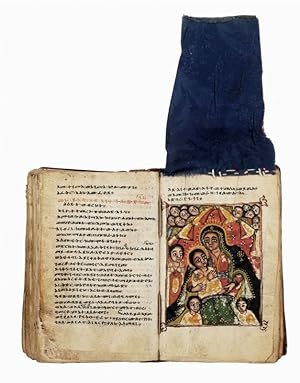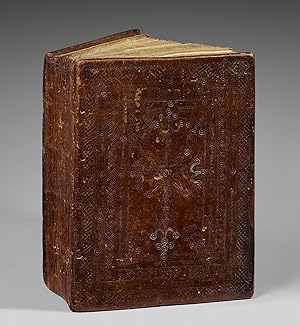manuscrit enlumine (3 résultats)
Type d'article
- Tous les types d'articles
- Livres (3)
- Magazines & Périodiques
- Bandes dessinées
- Partitions de musique
- Art, Affiches et Gravures
- Photographies
- Cartes
-
Manuscrits &
Papiers anciens
Etat
- Tous
- Neuf
- Ancien ou d'occasion
Reliure
- Toutes
- Couverture rigide
- Couverture souple
Particularités
- Edition originale
- Signé
- Jaquette
- Avec images
- Sans impression à la demande
Pays
Evaluation du vendeur
-
Couverture rigide. Etat : Très bon. Éthiopie, XIXe siècle. In-8 de (131) ff. sur peau de vélin, 2 figures polychromes à pleine page protégées par du tissu, déchirure aux 6e et 46e feuillets. Texte écrit à l'encre noire et rouge, avec quelques bandeaux peints en tête de plusieurs chapitres, piqûres de réglure dans les marges extérieures. Relié en veau estampé à froid de l'époque sur ais de bois, dos lisse avec qq. usures. Reliure de l'époque.179 x 110 mm. --- Rare bible éthiopienne manuscrite sur peau de vélin. Elle est écrite en ge'ez, le langage liturgique de l'église éthiopienne.L'un des champs les plus significatifs de la culture éthiopienne est sa littérature, principalement des textes religieux en grec ancien et hébreu traduits en ancien ge'ez. Le ge'ez, l'une des langues les plus anciennes du monde, est encore utilisée par l'église orthodoxe éthiopienne, qui a ses propres coutumes et traditions. Les premières inscriptions en ge'ez (langue sémitique officielle de l'empire d'Axoum) datent du IVe siècle de notre ère, époque où florissait une dynastie puissante, qui reçut des influences grecques et sous laquelle eut lieu la conversion au christianisme. Le ge'ez s'écrit et se lit de gauche à droite, contrairement aux autres langues sémitiques.L'illustration comprend 2 peintures à pleine page aux couleurs vives et chatoyantes dont une Vierge à l'Enfant, ainsi que plusieurs bandeaux peints en-tête.Précieux manuscrit enluminé Ethiopien conservé dans sa reliure d'origine en cuir estampé à froid sur ais de bois. /// Éthiopia, 19th century.8vo [179 x 110 mm] of (131) ll. on vellum skin, 2 full-page polychrome figures protected by fabric, tear on the 6th and 46th leaves. Text handwritten with black and red ink, with a few painted borders at the head on several chapters, ruling stitching in the outer margins.Bound in contemporary blind-stamped calf over wooden boards, flat spine with a few wears. Contemporary binding. --- Rare Ethiopian bible handwritten on vellum skin.It is written in ge'ez, the liturgical language of the Ethiopian church.One of the most significant fields of Ethiopian culture is its literature, mainly religious texts in ancient Greek and Hebrew translated into ancient ge'ez. Ge'ez, one of the oldest languages in the world, is still used by the Ethiopian Orthodox church, which has its own customs and traditions. The first inscriptions in ge'ez (official Semitic language of the Axum Empire) date from the 4th century AC, when a powerful dynasty was flourishing, which received Greek influences and under which conversion to Christianity took place. Ge'ez is written and read from left to right, unlike other Semitic languages.The illustration contains 2 full-page paintings in vivid and bright colors including a Madonna and Child, as well as several painted head-pieces at the head.Precious Ethiopian illuminated manuscript preserved in its contemporary binding in blind-stamped leather over wooden boards.
-
Couverture rigide. Etat : Très bon. Éthiopie, XIXe siècle.Petit in-4 de (134) ff. sur peau de vélin, 13 figures polychromes à pleine page. Texte écrit à l'encre noire rubriqué sur deux colonnes, avec des titres et des noms de saints écrits en rouge. Exemplaire réglé à la pointe sèche, piqûres de réglure dans les marges extérieures. Relié en veau estampé à froid de l'époque sur ais de bois, dos lisse bien présent. Reliure de l'époque.205 x 148 mm. --- Rare bible éthiopienne manuscrite sur peau de vélin. Elle est écrite en ge'ez, le langage liturgique de l'église éthiopienne.L'un des champs les plus significatifs de la culture éthiopienne est sa littérature, principalement des textes religieux en grec ancien et hébreu traduits en ancien ge'ez. Le ge'ez, l'une des langues les plus anciennes du monde, est encore utilisée par l'église orthodoxe éthiopienne, qui a ses propres coutumes et traditions. Les premières inscriptions en ge'ez (langue sémitique officielle de l'empire d'Axoum) datent du IVe siècle de notre ère, époque où florissait une dynastie puissante, qui reçut des influences grecques et sous laquelle eut lieu la conversion au christianisme. Le ge'ez s'écrit et se lit de gauche à droite, contrairement aux autres langues sémitiques.Le présent manuscrit est d'un format peu courant, ce type de bible étant le plus souvent composée au format in-8.L'illustration, dans les teintes jaunes, bleues et roses, reprend les thèmes de l'iconographie des VIe et VIIe siècles. Elle comprend 13 peintures à pleine page aux couleurs vives et chatoyantes (Saint Georges terrassant le dragon, une Vierge à l'Enfant, Saint Michel archange vainqueur du démon, .).Précieux manuscrit enluminé éthiopien conservé dans sa reliure d'origine en cuir estampé à froid sur ais de bois. /// Ethiopia, nineteenth century.Small 4to [205 x 148 mm] of (134) ll. on vellum skin, 13 full-page polychrome paintings. Text written in black ink rubricated on two columns, with titles and names of saints written in red. Copy ruled with drypoint, ruling stains in the outer margins. Bound in its original blind-stamped calf over wooden boards, flat spine preserved. Contemporary binding. --- Rare Ethiopian bible handwritten on vellum skin.It is written in Ge'ez, the liturgical language of the Ethiopian church.One of the most significant fields of Ethiopian culture is its literature, mainly religious texts in ancient Greek and Hebrew translated into ancient Ge'ez. Ge'ez, one of the oldest languages in the world, is still used by the Ethiopian Orthodox Church, which has its own customs and traditions. The first inscriptions in Ge'ez (the official Semitic language of the Aksum Empire) date back to the fourth century AD, when a powerful dynasty flourished, which received Greek influences and under which the conversion to Christianity took place. Ge'ez is written and read from left to right, unlike other Semitic languages.The present manuscript is of an unusual format, this kind of bible being most often composed in an 8vo format.The illustration, in shades of yellow, blue and pink, takes up the themes of the iconography of the sixth and seventh centuries. It includes 13 full-page paintings in bright and shimmering colors (St George slaying the dragon, a Virgin and Child, St Michael the Archangel defeating the devil, .).Precious Ethiopian illuminated manuscript preserved in its original blind-stamped leather binding over wooden boards.
-
Couverture rigide. Etat : Très bon. Normal 0 21 false false false FR X-NONE X-NONE /* Style Definitions */ table.MsoNormalTable {mso-style-name:"Tableau Normal"; mso-tstyle-rowband-size:0; mso-tstyle-colband-size:0; mso-style-noshow:yes; mso-style-priority:99; mso-style-parent:""; mso-padding-alt:0cm 5.4pt 0cm 5.4pt; mso-para-margin-top:0cm; mso-para-margin-right:0cm; mso-para-margin-bottom:8.0pt; mso-para-margin-left:0cm; line-height:107%; mso-pagination:widow-orphan; font-size:11.0pt; font-family:"Calibri","sans-serif"; mso-ascii-font-family:Calibri; mso-ascii-theme-font:minor-latin; mso-hansi-font-family:Calibri; mso-hansi-theme-font:minor-latin; mso-bidi-font-family:"Times New Roman"; mso-bidi-theme-font:minor-bidi; mso-fareast-language:EN-US;} A shimmering illuminated manuscript illustrated with 6 full-page paintings of remarkable quality of execution and shimmering colours, testifying to the art of French illuminators under the reign of Charles VIII. The text: Ll. 1-12v Calendar in French with a saint for each day of the year in gold, blue and red ink derived from Perdrizet 1933 (presence of Saint Arragonde on 30 January, Saint Amant on 6 February, Saint Vaast on 8 August). Ll. 13-18v Pericopes of the 4 Gospels. Ll. 18v-25 Obsecro te and O Intemerata written in the masculine. Ll. 26-86 Hours of the Virgin for use in Paris. Ll. 87-105v Psalms of Penance followed by s. Denis, s. Gervais, s. Prothais and s. Germain. Ll. 106-112v Hours of the Cross and Hours of the Holy Spirit. Ll. 113-148v The Office of the Dead for the use of Paris. Ornamentation: The decoration includes 6 large full-page miniatures of beautiful factory. L. 13 Saint John the Evangelist on the island of Patmos with the eagle and a large rock behind him. L. 26 Annunciation: the Virgin has her hands crossed on her chest, her book is placed behind her, the angel greets her. L. 87 David defeating Goliath in a beautiful landscape of blue and green hills. L. 106 Crucifixion: the Virgin and Saint John are praying on the left, the centurion and his soldiers are on the right. The centurion is wearing a knotted belt. The sky is filled with small gold dots. L. 110 Pentecost: the scene is built on a diagonal. The Virgin prays in front followed by the apostles. St John is next to her and St Peter behind her. L. 113 Job on the dunghill with a friend wearing a knotted belt. Superb framings on four sides of the miniatures with scaled trunks and a hybrid on l. 13, a heron on l. 87, a hybrid woman on a gold background on l. 110, a hybrid on ll. 26 and 113 on a compartmented parchment background. Side borders on l. 18v, 22v, at the head of the Hours on ll. 48v, 60, 65, 68, 71v, 75, 81v. Initials on 1 and 2 lines with red and blue background letter in gold, initials on 3 lines in Paris with gold background letter in white and pink scroll and red background letter in white and blue scroll. Very beautiful manuscript in perfect condition illuminated by an artist with several names. J. Plummer and J. Lauga name him le Maître du Morgan 26 and set the beginning of his career in Langres (J. Lauga, Les manuscrits liturgiques dans le diocèse de Langres à la fin du Moyen Age. Les commanditaires et leurs artistes, 2007, Université de Paris IV, direction F. Joubert, vol. 1, p. 273-284, vol. 2, notice 58, p. 577-611, notice 56, p. 541-560). J. Plummer and Fr. Avril attribute to him the Jeu des échecs moralisés (Paris BnF., Ms. Fr. 2000). Fr. Avril gives him the name of Maître du Romuléon of the Museum of Cluny according to the fragments (Cl. 1804 and Cl 1819) of Limoges, Niort Rés. G.2.F. The artist was inspired by Germanic models. Thus the comparison of Jesus before Pilates in Morgan 26 is an exact replica of an engraving by Israel van Meckenem reproduced in Bartsch illustrated 493 (fig. 354-355) as recognized by J. Lauga. The moralized chess bears the arms of Nicolas d'Anjou, grandson of King René, son of Jean de Galabre, who died in 1473, but the style is more reminiscent of the 1480s, as suggested by N. Reynaud in 1993 (.




![Image du vendeur pour [Heures à l'usage de Paris]. mis en vente par Librairie Camille Sourget](https://pictures.abebooks.com/inventory/md/md31552535766.jpg)